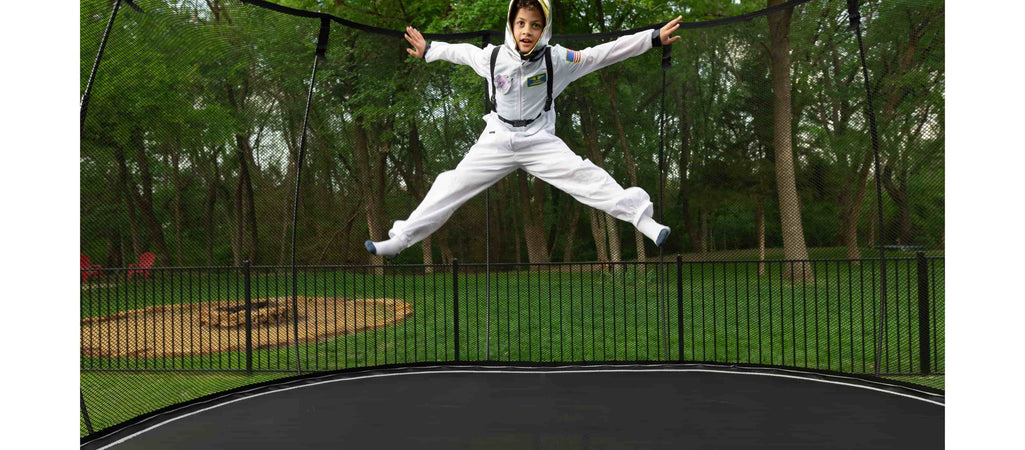Bouncing Into Orbit: What NASA’s Trampoline Study Revealed
Unlock the Secrets of Space Fitness: Find out what NASA's Trampoline Study revealed and how it might open your eyes to a new fitness solution!
min read

Did you know that NASA studied trampolines to help astronauts stay healthy in space? It's true!
In the 1980s, NASA conducted a study to investigate the effectiveness of trampoline exercise in preventing bone loss and muscle atrophy in astronauts. The results were quite astounding.
In this article, we at Springfree Trampoline will dive into the famous NASA Trampoline Study to show you what it proved about trampoline exercise. From there, you can decide whether bouncing is your cosmic key to fitness.
NASA Trampoline Study Findings
The NASA study on trampolines compared the physical effects of treadmill running and trampoline jumping on eight young men.
They measured body acceleration, oxygen uptake, and heart rate during different activities. A competition-style trampoline (9 ft x 15 ft) was used for this Study.
Here’s what they found: 10 minutes of bouncing burns MORE calories than 30 minutes of running.
Not only that but bouncing on a trampoline was found to be 68% more effective than jogging.
Here are some other key findings from the NASA Trampoline Study:
- When you're on a trampoline and your heart rate and oxygen use are similar to when you're running, the physical stress your body experiences is actually greater – which increases your strength.
- When you're bouncing on a trampoline, as long as the gravitational force (G-force) you experience is below 4-G's, your body uses oxygen more efficiently compared to treadmill running.
- When running on a treadmill, the force experienced at the ankle is consistently over twice as much as the force felt at the back and forehead. In other words: trampolining is gentler on your body than running.
- When it comes to energy cost, jumping on a trampoline can offer a more effective gravitational stimulus compared to other activities. In simpler terms, trampoline jumping gives your body the right kind of workout it needs with less energy consumption.
Check it out: Treadmill or Trampoline? Make the Smart Investment

Zero Gravity Insights on Trampoline Exercise
You might not be flying into space anytime soon, but you can still reap the benefits of trampoline exercise just like an astronaut would.
Some of the details of NASA’s Trampoline Study can get technical, but basically what the researchers found is that trampolines are:
- More effective than running.
- More efficient than running.
- Require less effort than running.
- Puts less stress on joints than running.
When people think of working out, many will automatically go toward running as an option. While running can be hugely beneficial, the NASA trampoline study results show that it may not be the best way for you to accomplish your workout goals.
9 Pros of Trampoline Jumping
There are many notable health benefits of trampoline jumping that go beyond what the NASA Trampoline Study showed. Here is a list of the main benefits of bouncing:
1. Cardiovascular Fitness: Jumping on a trampoline can elevate your heart rate, providing a cardiovascular workout that helps improve your heart and lung health.
2. Improved Balance and Coordination: The act of bouncing and maintaining balance on a trampoline can enhance your coordination and spatial awareness.
3. Strengthened Muscles: Jumping engages various muscle groups, particularly the legs, which can help tone and strengthen muscles over time.
4. Weight Management: Regular trampolining can assist in weight management by burning calories and improving metabolism.
5. Lymphatic System Stimulation: Bouncing on a trampoline promotes lymphatic fluid circulation, which can aid in detoxification and boost your immune system.
6. Reduced Impact on Joints: Trampolining has less impact on your joints compared to activities like running, making it suitable for individuals with joint concerns.
7. Enhanced Bone Density: The repetitive, weight-bearing nature of trampoline exercise can contribute to improved bone density, particularly important for preventing osteoporosis.
8. Stress Reduction: Physical activity releases endorphins, which can reduce stress and enhance mood.
9. Child Development: Trampolines can aid in children's physical development, promoting balance, strength, and coordination.
Not to mention the fact that trampolines are fun! Running or other physical activities are not always enjoyable, and that can make it difficult to be consistent when working out.
Trampolines give you the best of both worlds: fun but also effective!

4 Cons of Trampoline Exercise
Just like any exercise equipment, there are a few notable cons to trampoline exercise:
1. There is a risk of sprains and fractures.
2. Existing spine conditions may be aggravated.
3. Progress in muscle strength development might plateau.
4. Costs money (potentially over $1,000 for a high-quality trampoline) and takes up space.
If you follow trampoline safety rules and invest in a good-quality trampoline or rebounder, your chances of injury will be significantly decreased. However, we wouldn’t be doing our job as objective educators if we did not mention some of the safety risks of trampolines.
Which Type of Trampoline Is Right for You?
The NASA Trampoline Study proved it: Trampoline jumping is more effective and efficient than running.
If you’re tired of the ‘old way’ of working out, it may be time to look into trampolines as an alternative form of exercise.
You know the benefits of trampolines, but which trampoline type is right for executing your fitness goals?
Believe it or not, there are nine (yes nine!) types of trampolines you can purchase. They range from mini trampolines (rebounders) to large backyard trampolines, to even water trampolines.
But you don’t have to look any further than the article below to find out all that you need to know to make an informed decision.
Check it out: 9 Types of Trampolines Explained | Which One Is Right for You?



